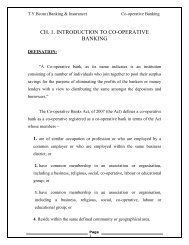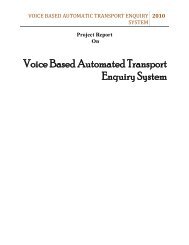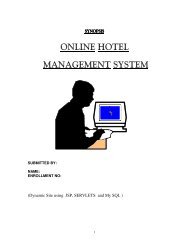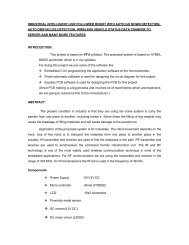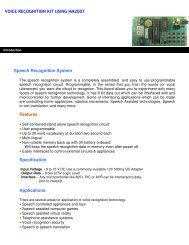Cloud Computing â âWhats the Buzz? - Ask, Find, Discuss about ...
Cloud Computing â âWhats the Buzz? - Ask, Find, Discuss about ...
Cloud Computing â âWhats the Buzz? - Ask, Find, Discuss about ...
- No tags were found...
Create successful ePaper yourself
Turn your PDF publications into a flip-book with our unique Google optimized e-Paper software.
commitment and allows users to provisionresources on demand. Unlike PaaS services,<strong>the</strong> IaaS provider does very little managemento<strong>the</strong>r than keep <strong>the</strong> data center operationaland users must deploy and manage <strong>the</strong>software services <strong>the</strong>mselves‐‐just <strong>the</strong> way<strong>the</strong>y would in <strong>the</strong>ir own data center. AmazonWeb Services Elastic Compute <strong>Cloud</strong> (EC2) andSecure Storage Service (S3) are examples ofIaaS offerings.Types of <strong>Cloud</strong>sAs we focus on building <strong>the</strong> cloud, a numberof models have been developed for deployinga cloud infrastructure.Public <strong>Cloud</strong>sIn a public cloud, external organizationsprovide <strong>the</strong> infrastructure and managementrequired to implement <strong>the</strong> cloud. Publicclouds dramatically simplify implementationand are typically billed based on usage. Thistransfers <strong>the</strong> cost from a capital expenditureto an operational expense and can quickly bescaled to meet <strong>the</strong> organization’s needs.Temporary applications or applications withburst resource requirements typically benefitfrom <strong>the</strong> public cloud’s ability to ratchet upresources when needed and <strong>the</strong>n scale <strong>the</strong>mback when <strong>the</strong>y are no longer needed. In aprivate cloud, <strong>the</strong> company would need toprovision for <strong>the</strong> worst case across all <strong>the</strong>applications that share <strong>the</strong> infrastructure. Thiscan result in wasted resources whenutilization is not at its peak.Hybrid <strong>Cloud</strong>sPrivate <strong>Cloud</strong>sIn a private cloud, <strong>the</strong> infrastructure forimplementing <strong>the</strong> cloud is controlledcompletely by <strong>the</strong> enterprise. Typically,private clouds are implemented in <strong>the</strong>enterprise’s data center and managed byinternal resources.A private cloud maintains all corporate data inresources under <strong>the</strong> control of <strong>the</strong> legal andcontractual umbrella of <strong>the</strong> organization. Thiseliminates <strong>the</strong> regulatory, legal and securityconcerns associated with information beingprocessed on third party computing resources.Currently, private clouds require CapitalExpenditure and Operational Expenditure aswell as highly skilled labor to ensure thatbusiness services can be met.To meet <strong>the</strong> benefits of both approaches,newer execution models have been developedto combine public and private clouds into aunified solution.Applications with significant legal, regulatoryor service level concerns for information canbe directed to a private cloud. O<strong>the</strong>rapplications with less stringent regulatory orservice level requirements can leverage apublic cloud infrastructure.Implementation of a hybrid model requiresadditional coordination between <strong>the</strong> privateand public service management system. Thistypically involves a federated policymanagement tool, seamless hybridintegration, federated security, informationasset management, coordinated provisioningcontrol, and unified monitoring systems.7



